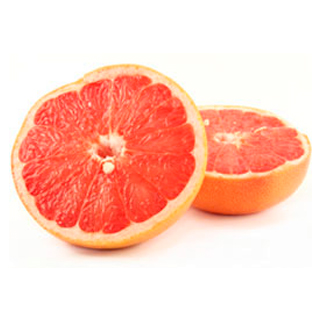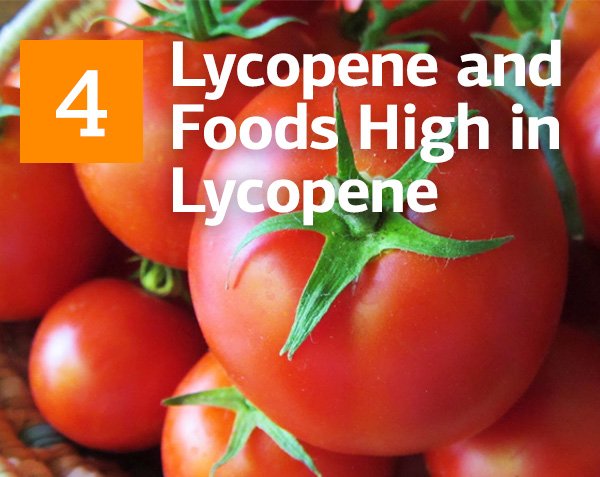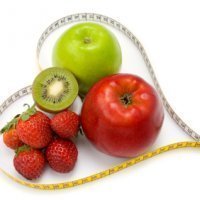Lycopene and Foods High in Lycopene
What is Lycopene?
Lycopene is a pigment that determines the red color of some fruits and vegetables.
Lycopene stimulates digestion and helps to decrease cholesterol level. It suppresses pathogenic intestinal microflora, prevents development of atherosclerosis, lowers appetite and promotes weight loss. Lycopene has anti-bacterial and anti-viral features, strengthens the walls of blood vessels and capillaries, has beneficial effect on skin, nourishes and rejuvenates dry, wrinkled and pigmented skin. It is also used as a prophylactic remedy against various hepatic disorders.
Researches have proven that lycopene diet reduces risks of several chronic diseases, such as cardio-vascular disorders, cancer and age-related macular degeneration. It even can be concluded that people with a large amount of lycopene in their blood have twice lower chances to be affected by heart diseases, than those with a small amount of lycopene.
Lycopene is a strong antioxidant that can destroy free radicals, which are aggressive molecules that cause various diseases by destroying cell membranes and attacking DNA. People sick with HIV infection, cold and high cholesterol level usually have a small amount of lycopene in their blood. Smoking and drinking alcohol does not always decrease lycopene amount in blood, unlike the aging process.
As our body cannot produce lycopene by itself, this enzyme must be consumed with food. Lycopene is contained in foods like tomatoes, ketchup, pizza sauce and tomato juice. As a rule, these foods are the main suppliers of lycopene in our diet. But the biggest amount of lycopene can be provided to our bodies by tomato paste. 1 tablespoon can fully satisfy our daily need in lycopene. Tomato paste is 30 times richer in lycopene than fresh tomatoes and 6 times richer than ketchup. Such fruits like pink grapefruit, guava and watermelon also include lycopene, but in much smaller amounts.
Despite the fact that the main source of lycopene for humans is tomatoes or products made of them, biological features of this enzyme can vary drastically. For example, in the process of sauce cooking, tomatoes are stewed in oil and lycopene as oil-soluble enzyme highly increases its ability to soak. Lycopene’s chemical formula is changed under the influence of heat. It becomes more digestible. Lycopene from tomato paste is 2.5 times faster absorbed, than the one form fresh vegetables.
Although there are no detailed suggestions on including lycopene to our diet, according to studies, drinking two cups (about 500 ml.) of tomato juice every day can extremely decrease oxidation of bad cholesterol, and boost immunity.
In addition, lycopene protects our skin from harmful sunlight. Scientists have proved that the systematic consumption of lycopene-containing foods rejuvenates the skin and makes it more elastic. Lycopene-treated skin showed 10 times more antioxidant activity than untreated. According to the recommendations in terms of consumption of biologically active substances, about 5mg of lycopene should be consumed by an adult per day, the tolerable upper intake level is 10mg per day.
Lycopene Deficiency
Lycopene deficiency is a problem of all people whose diet is characterized by low consumption of fruits and vegetables. As lycopene is one of the main carotenoids, its deficiency may result in poor immunity and chronic diseases. Lack of this enzyme is especially dangerous in a long-time perspective, because it can lead to cancers or heart diseases.
Dietary Toxicity Of Lycopene
Although lycopene is not toxic and does not have any side effects, people who take high doses for a long time may experience skin color change. It may acquire an orange-yellow tone.
Foods High In Lycopene
1. Tomatoes

| Tomatoes, Red, Ripe, Year Round Average | |
| 100 g | 1 medium whole (2-3/5 inch dia) (123 g) |
| Lycopene: 2573 mcg (257% DV) |
Lycopene: 3165 mcg (316% DV) |
Lycopene has a very interesting and unique feature. Unlike most nutrients in tomatoes, it is not destroyed in the process of heating, but rather concentrated! After two minutes of cooking or roasting tomatoes quantity of lycopene in them increases by one-third.
Processing tomatoes gives a similar result. If fresh tomatoes contain 50mg of lycopene per kilogram, tomato juice and ketchup can supply your body with up to 140mg, and tomato paste includes up to 1500mg of this enzyme.
Moreover, lycopene in tomato paste or sauce is faster metabolized by your body. These products contain vegetable oils, and since all carotenoids are fat-soluble substances, even 1% of fat in the food can significantly improve lycopene absorption.
Nutritionists recommend consuming orange tomatoes. This type is the highest in lycopene. They contain 200 times more of this enzyme than the red ones. In order to satisfy your daily lycopene need, you must to eat 200-500g of red tomatoes, or 50g of tomato paste.
In case you are not fond of tomatoes, your ability to obtain an adequate quantity of lycopene from food is sharply reduced, because all the other fruits, which contain it, are not frequent guests on our tables. For example, a grapefruit (but only the red one!) includes a little less amount of lycopene than tomatoes, but, in order to get the daily need, you will have to eat two grapefruits every day! And if you prefer guava, you will have to eat four of them.
2. Grapefruit

| Grapefruit, Pink And Red And White, All Areas | |
| 100 g | 1 medium (approx 4 inch dia) (128 g) |
| Lycopene: 1135 mcg (114% DV) |
Lycopene: 1453 mcg (145% DV) |
Loved by many, grapefruit is full of healthy ingredients like lycopene and vitamin C and is an excellent dietary product. 100g of grapefruit juice contains 45mg of vitamin C. It is high in such nutrients as vitamins A, B1, B2 and D, magnesium, potassium, calcium, iron and zinc. The content of lycopene per 100g of fruit is 1135mcg. Plus, it is a great remedy against overweight.
I remember many years ago, I used to have lunches with my colleague in a cafe. She would always order a glass of grapefruit juice. Imagine my surprise when she told me that it was the way she kept fit. It was the first time I have heard about the ability of grapefruit to burn calories. Nowadays I use this method myself and recommend it to all of my friends.
3. Watermelon

| Watermelon | |
| 100 g | 1 wedge (approx 1/16 of melon) (286 g) |
| Lycopene: 4532 mcg (453% DV) |
Lycopene: 12962 mcg (1296% DV) |
The main component of watermelon is water (92%), but it also includes lots of proteins, carbohydrates, fats, dietary fibers, and vitamins A, B1, B2, B6, B9, C and E, as well as calcium, phosphorus, magnesium and iron. Lycopene’s content in the fruit is very large compared to other fruits and veggies. Thanks to lycopene, watermelon can suspend the development of inflammation of the digestive tract, guarding the skin from sunburn and oxidative stress. Watermelon is a perfect source of liquid on a warm summer day. It is tasty and full of nutrients. The only minus is that we can enjoy it during only one season in a year.
4. Guava

| Guavas, Common | |
| 100 g | 1 fruit, without refuse (55 g) |
| Lycopene: 5204 mcg (520% DV) |
Lycopene: 2862 mcg (286% DV) |
Pink or red guava also contains a lot of lycopene. This super fruit contains 4 times more vitamin C than an orange. 100g of guava contains only 68 calories and about 5g of fiber. Fiber helps to keep your weight, supports work of the digestive tract and helps decrease cholesterol level. Eating guava will also benefit your skin. Vitamins A, B, C and potassium make the skin firmer and hydrated. Lycopene in guava protects cells from harmful UV radiation and toxins. Guava is an excellent source of water as 81% of the fruit is liquid. That is why the fruit plays a significant role in skin hydration.









